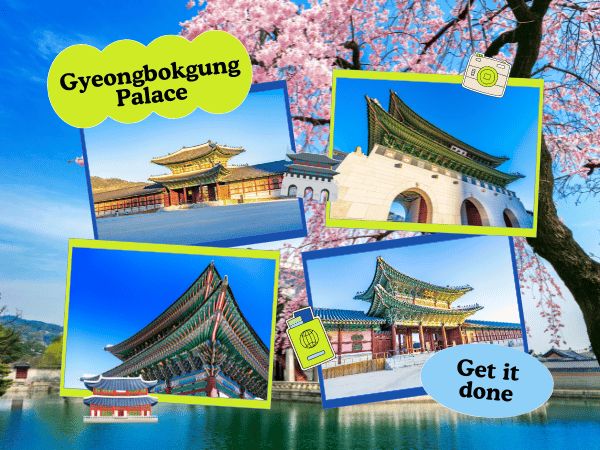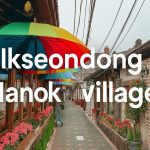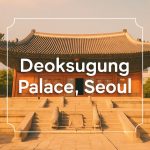📍 Address: 161, Sajik-ro, Jongno-gu, Seoul
💲 Entrance Fee:
- Adults (19-64) 3,000 won, Children (7-18)1,500 won, Under 7 and over 64 Free
- Combination Ticket: 10,000 won (adult), 5,000 won (child) for 4 palaces and Jongmyo Shrine
🕒 Opening Hours:
- Nov-Feb: 9:00-17:00
- Mar-May, Sep-Oct: 9:00-18:00
- Jun-Aug: 9:00-18:30
- Last admission: 1 hr before closing
- Closed on Tuesdays
🚇 Nearest Subway Station:
- Gyeongbokgung Station (Line 3, Exit 5) – 3 mins walk
- Gwanghwamun Station (Line 5, Exit 2) – 7 mins walk
📝 Additional Info:
- Free Guided Tours: 11:00, 13:30, 15:30 (English), 10:30, 15:00 (Chinese)
- Changing of the Royal Guard Ceremony: 10:00, 14:00 (20 mins)
- Gwanghwamun Gate Guard on Duty Ceremony: 11:00, 13:00 (10 mins)
- Gatekeeper Military Training: 9:35, 13:35 (15 mins)
Gyeongbokgung Palace is the star of Seoul’s Five Grand Palaces.
It’s huge, beautiful, and super old – we’re talking 1395 old!
The name means “Palace Greatly Blessed by Heaven.” Pretty fancy, right?
Is it Worth Visiting Gyeongbokgung Palace?
Yes, 100%! Gyeongbokgung Palace is a must-see attraction in Seoul.
Here’s why:
- Historical significance: It’s the largest and most important of the Five Grand Palaces of the Joseon Dynasty. You’re literally walking through 600 years of Korean history!
- Stunning architecture: The palace buildings are beautiful examples of traditional Korean design. The intricate details and vibrant colors are seriously impressive.
- Cultural experience: You can witness the Changing of the Guard ceremony, which is a fun glimpse into historical Korean customs.


- Photo opportunities: The palace grounds are incredibly picturesque. You’ll get some amazing shots for your Instagram!
- Educational value: There’s a National Palace Museum on-site where you can learn more about Korean royal history.
- Peaceful escape: Despite being in the heart of bustling Seoul, the palace grounds offer a serene retreat from the city noise.
- Seasonal beauty: The palace is gorgeous year-round, from cherry blossoms in spring to snow-covered roofs in winter.
Tip: Try to visit on a weekday if possible. It’s less crowded and you’ll have a more relaxed experience.
Gyeongbokgung Palace history
This palace has been through a lot. It was the main royal palace of the Joseon dynasty for about 500 years. But it wasn’t all smooth sailing.
The palace got burned down during a war in the 1590s and was left empty for nearly 300 years. Talk about a fixer-upper!


In the 1800s, they finally got around to rebuilding it. But then it got damaged again during Japanese occupation.
Since the 1990s, they’ve been working hard to restore it to its former glory. And let me tell you, it’s looking pretty spectacular now!
What to See at Gyeongbokgung Palace?
There’s so much to see here, you could spend a whole day exploring.
Some must-see spots:
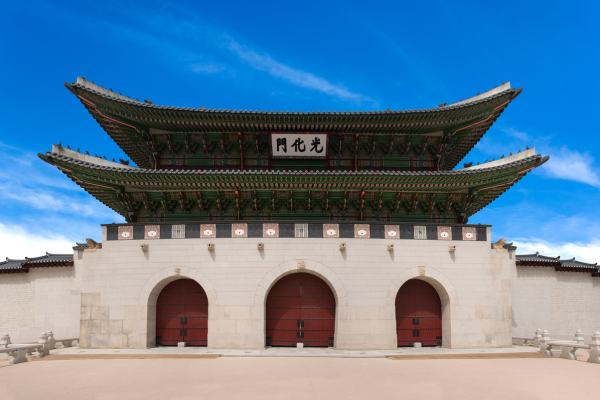

- Gwanghwamun Gate: This is the main entrance. It’s massive and super impressive.
- Geunjeongjeon Hall: This was where the king met his officials. It’s got a fancy throne inside.
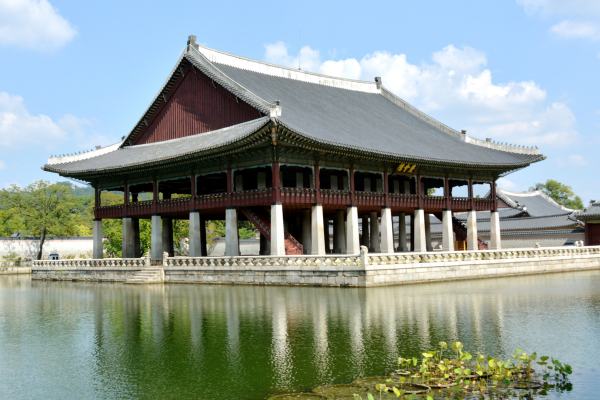
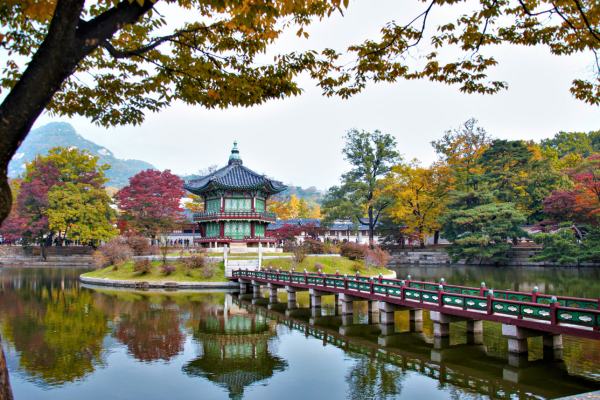
- Gyeonghoeru Pavilion: A beautiful pavilion on an artificial island. It’s gorgeous, especially at sunset.
- Hyangwonjeong Pavilion: Another pretty pavilion on a pond. It’s a popular photo spot.
Don’t miss the Changing of the Guard ceremony. It happens twice a day and it’s really cool to watch.
Tip: Get there early for the Changing of the Guard to snag a good viewing spot!
What Time is the Changing of the Guard Ceremony?

The Changing of the Guard ceremony happens twice a day – at 10 AM and 2 PM. It lasts about 20 minutes and it’s really fun to watch.
The guards are dressed in colorful traditional outfits and there’s lots of drumming and marching.
Tip: The ceremony doesn’t happen if it’s raining, so check the weather forecast before you plan your visit around it.
Gyeongbokgung Palace Map
The palace is huge, so grab a map at the entrance. It’ll help you navigate and make sure you don’t miss anything important. The layout is pretty straightforward once you get your bearings.
How to Get to Gyeongbokgung Palace?
By Subway:
- Gyeongbokgung Station: Take Line 3 (the orange line) and get off at Gyeongbokgung Station. Use Exit 5; the palace is about a 3-minute walk from the station.
- Gwanghwamun Station: Take Line 5 (the purple line) and get off at Gwanghwamun Station. Use Exit 2; it takes approximately 7 minutes to walk to the palace.
By Bus:
- Several bus lines stop near Gyeongbokgung Palace. Check local routes and schedules for the best options based on your starting point.
By Taxi:
- You can take a taxi directly to the palace. Provide the driver with “Gyeongbokgung Palace” or the address: 161 Sajik-ro, Jongno-gu, Seoul.
By Walking:
- If you’re staying nearby, walking to Gyeongbokgung Palace can be a pleasant way to explore the area. The palace is centrally located and accessible from many parts of Seoul.

Ready to explore Seoul? Discover a world of exciting activities and must-see attractions in our comprehensive guide:
How Much Does It Cost to go to The Gyeongbokgung Palace?
The cost to visit Gyeongbokgung Palace is pretty reasonable, especially considering what you get to see.
- Regular admission fees:
- Adults (19-64): 3,000 won (about $2.50 USD)
- Youth (7-18): 1,500 won (about $1.25 USD)
- Children (6 and under): Free
- Special rates:
- Seniors (65 and over): Free
- Wearing hanbok (traditional Korean clothing): Free
- Combination ticket: If you’re planning to visit multiple palaces, consider buying a combination ticket. For 10,000 won (about $8.50 USD), you get access to four palaces (Gyeongbokgung, Changdeokgung, Changgyeonggung, Deoksugung) and Jongmyo Shrine. This ticket is valid for three months, so it’s a great deal if you’re staying in Seoul for a while.
- Guided tours: The palace offers free guided tours in English, Japanese, and Chinese. These are included in your admission price.
- Audio guides: Available for an additional fee (about 3,000 won) if you prefer a self-guided experience.
Remember, the palace is closed on Tuesdays, so plan your visit accordingly.
Also, if you’re on a tight budget, consider visiting on the last Wednesday of the month when admission is free for everyone!
Tip: If you’re into photography, consider budgeting a bit extra to rent a hanbok. Not only will you get free entry, but you’ll also get some amazing photos of yourself in traditional Korean clothing at the palace!
Is Gyeongbokgung Palace Open at Night?
Sadly, the palace usually closes before dark. But a few times a year, they open it up for night tours.
If you’re lucky enough to be there during one of these events, don’t miss it! The palace lit up at night is absolutely magical.
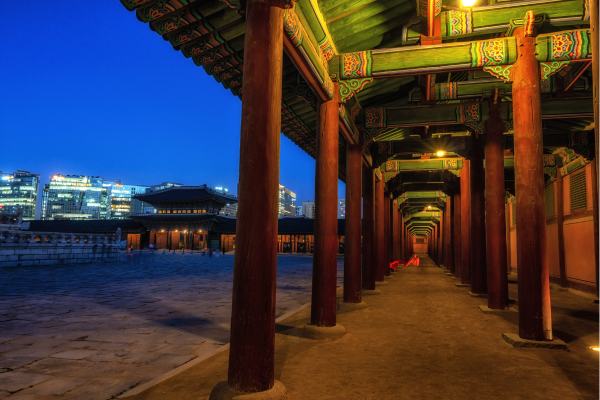
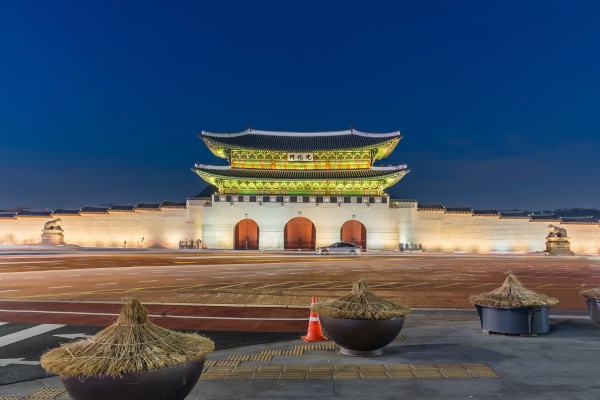
It’s recommended to check the official website for the current schedule and to make advance reservations, as night tours often have limited availability.
Tip: Keep an eye on the official palace website for night opening announcements.
Can I Wear Shorts to Gyeongbokgung Palace?
Good news – yes, you can! There’s no strict dress code.
But remember, it’s a respected historical site, so maybe skip the super short shorts or revealing tops.
Looking for more exciting activities and places to explore in Seoul? Don’t miss out on our comprehensive guide to the best things to do Seoul!
FAQ About Gyeongbokgung Palace
To help you plan your visit and make the most of your experience, we’ve compiled answers to some frequently asked questions about Gyeongbokgung Palace.
- Is Gyeongbokgung Palace free entrance? No, there’s a small fee. Adults pay 3,000 won (about $2.50 USD).
- Is Gyeongbokgung Palace free if you wear hanbok? Yes! Wearing traditional Korean hanbok gets you free entry.
- How long to walk in Gyeongbokgung? Plan for 2-3 hours to see the main highlights.
- Which is better Gyeongbokgung or Changdeokgung? Gyeongbokgung is larger and more popular. Changdeokgung has a beautiful Secret Garden. Both are great, but Gyeongbokgung is usually recommended if you can only visit one.
- What time is the parade at Gyeongbokgung Palace? The Changing of the Guard ceremony happens at 10 AM and 2 PM daily.
- Can you take pictures at Gyeongbokgung Palace? Yes, photography is allowed in most areas. Just be respectful and follow any posted signs.

